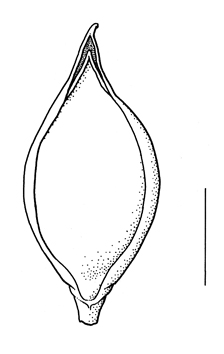7. Echinochloa muricata (Beauv.) Fernald var. muricata (incl. var. microstachya) (N-Am.) – A locally abundant but long overlooked alien. Now more or less widely naturalised and much increasing, especially in parts of Flanders (Hoste 2004, 2006b). Most commonly found as a weed in maize fields, more rarely in other habitats, for instance on the gravelly banks of river Maas or on sand raised sites (for instance in Antwerpen-Linkeroever). Such populations might have been introduced by migrating birds (prickly spikelets easily adhere). Furthermore increasingly found on dumps, along road verges, on pond margins and in urban areas, possibly as a birdseed alien (here perhaps only temporarily). Finally also regularly seen as an ephemeral introduction in port areas, especially in the vicinity of grain elevators.
Echinochloa muricata doubtlessly still is imperfectly known in Belgium and its actual distribution uncertain. However, it surely is much less common in Wallonia and perhaps only ephemeral (seen for instance in a damp, worked-up road verge near Saint-Ghislain in 2010).
Echinochloa muricata is, with some experience, easily distinguished from E. crus-galli (see key). However, it is itself also a rather variable species (Hoste 2004). The plant currently naturalised in Belgium belongs to var. microstachya Wiegand, characterised by rather small spikelets (3-3,5 mm). The delimitation with var. muricata (with spikelets usually more than 4 mm long) is often blurred and intermediate forms have been recorded. Typical plants of variety muricata were collected at least twice in Belgium since 2000, each time associated with soybean importation in port areas. However, both are probably best considered as two extreme forms of a single variable species. Another variant, var. wiegandii, seems more characteristic (see there).






Selected literature:
Gregor T. (2006) Setaria faberi Herrm. und Echinochloa muricata (P. Beauv.) Fernald in Mais-Äckern um Vechta. Osnabrücker Naturwiss. Mitt. 32: 53-58.
Hoste I. (2004) The naturalisation history of Echinochloa muricata in Belgium with notes on its identity and morphological variation. Belg. Journ. Bot. 137: 163-174. [available online at: http://alienplantsbelgium.be/sites/alienplantsbelgium.be/files/Echinochl...
Hoste I. (2006a) Echinochloa crus-galli. In: Van Landuyt W., Hoste I., Vanhecke L., Van den Bremt P., Vercruysse W. & De Beer D., Atlas van de flora van Vlaanderen en het Brussels gewest. Instituut voor Natuur- en Bosonderzoek, Nationale Plantentuin van België en Flo.Wer: 353.
Lambinon J. (1993) Quelques données inédites sur des graminées adventices ou subspontanées en Belgique. Belg. Journ. Bot. 126: 3-12.
Pacyna A., Rostański K. & Guzik J. (1999) Echinochloa microstachya subsp. microstachya (Poaceae) – a new casual plant in the Polish flora. Fragm. Flor. Geobot., suppl. 7: 165-177.
Rombout R. (2011) Stekelige hanenpoot (Echinochloa muricata): competitiviteit en reactie ten aanzien van herbiciden. Masterproef voorgedragen tot het behalen van de graad van Master in de bio-ingenieurswetenschappen: landbouwkunde. Universiteit Gent, Faculteit Bio-ingenieurswetenschappen: 90 p. [available online at: http://lib.ugent.be/fulltxt/RUG01/001/789/779/RUG01-001789779_2012_0001_AC.pdf]
Scholz H. (1997) Echinochloa muricata, eine vielfach verkannte und sich einbürgernde Art der Deutschen Flora. Flor. Rundbr. 29: 44-49.
Verloove F. (2002) Ingeburgerde plantensoorten in Vlaanderen. Mededeling van het Instituut voor Natuurbehoud n° 20: 227 p.
Verloove F. & Vandenberghe C. (1997) Nieuwe en interessante voederadventieven in België en aangrenzend Nederland, hoofdzakelijk in 1996. Dumortiera 68: 13-26.

